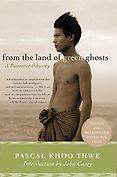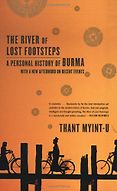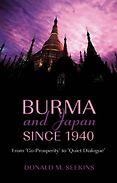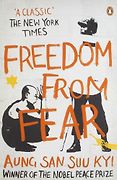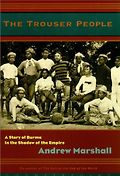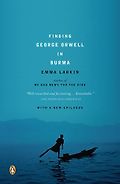Tell us about Andrew Marshall’s The Trouser People.
A great book. It’s an interesting mix of tracking this Victorian footballer, Sir George Scott, who wrote a lot about Burma, and an exploration of contemporary Burma. Scott was one of the few colonials who really seemed to understand Burma and be interested in Burmese culture and history. He wrote under a Burmese pseudonym, Shway Yoe. This refers to a comical figure the Burmese portray when they have festivals. Under that pseudonym Scott wrote many books about Burma which people actually thought were written by a Burmese, such was the depth and understanding in them. He also introduced football, and it is still extremely popular in Burma.
So the Trouser People are the British?
In Aung San Suu Kyi’s speeches around 1988-89 she used symbolism that was very easy to understand. She was addressing villagers and country people and needed to be able to reach them. She referred to the soldiers as trouser people, because they wear trousers not longis (sarongs) like most Burmese do. The trouser people was also the Burmese name for the British during colonial times. She just pointed out that they had trouser oppressors in the past and now they have another bunch of trouser people oppressing them now: the military. She called her struggle for democracy the second struggle for independence.
Apart from trousers and football, was there anything good about the colonial period, as far as Burma is concerned?
The British did introduce modern education and a parliamentarian style of government, which didn’t really succeed. Burma was fairly well developed in comparison to other countries in the region and they had a high literacy rate. But actually, due to monastic education for both girls and boys, they had a very high literacy rate even before the British came.
I was wondering how these present trouser people compare to the Burmese of the last dynasty. Are the military just crypto-colonials or can they really lay claim to some legacy?
Until Aung San Suu Kyi returned in 1988, her father Aung San was the official national hero. He stood for Unity in Diversity: all the nationalities in Burma should live together, there should be no discrimination etc. In 1989, after the military had crushed the uprising and reasserted power, they reinterpreted the whole concept of Burma. They changed the name to Myanmar claiming that Myanmar meant not only the Burmese but all the other ethnic groups as well. That is linguistically and historically incorrect. Aung San had discussed this back in the 1930s and concluded that Myanmar is just the name for the Mandalay kingdom and that Burma was the name for the country. In fact there is no name, nor has there ever been, that covers the country and all the ethnic groups, not until the British came and established the colony. The legacy of Aung San’s Unity in Diversity was replaced by this new Unity concept of Myanmar: one nation, one people, one language. Aung San, as national symbol, was pushed to the background. In the new capital in Nayipyidaw they have erected these huge statues of medieval warrior kings, they represent the new Burma that the military would like to see. There is some irony here, the problem with these kings is that they were excellent warriors and conquerors, but once they had taken territory they didn’t know how to rule it. They never built up any administration, and institutions so the Burmese empires collapsed when the kings died. Burma today is very much the same, they are trying to conquer these ethnic areas by force but they don’t know how to govern properly. The medieval kings are not very good role models for the state.
Emma Larkin’s Finding George Orwell in Burma is also something of a political travelogue. How does her approach differ from Andrew Marshall’s?
I think the main difference between Andrew’s and Emma’s books is that Andrew, who is a very gifted writer, makes places and events come alive; Emma makes people she meets come alive. She is more down-to-earth, probably because she speaks the language.
Emma’s book was partly inspired by a Burmese joke about Orwell. Did you ever come across this in your own experience?
The Burmese are quite aware of Orwell and his Burmese Days is quite famous there. The old joke in Burma is: ‘Have you read Burmese Days?’ ‘Yeah, it’s good but Orwell actually wrote a Burmese trilogy. The first was Burmese Days, about the colonial period, the second was Animal Farm, about the Burmese road to socialism and the third, 1984, about the present regime.’
Both Andrew Marshall and Emma Larkin seized on an interesting concept – if you want to make Burma interesting to the rest of the world you have to find a westerner who is part of the story.
There is something else that I find curious – this romantic attachment that Burma seems to inspire. Emma Larkin attributes it in part to the legacy of Kipling’s poem Mandalay. What do you make of this?
It probably stems from this colonial myth about Burma, that it was this golden country in South East Asia, not as big and frightening as India but still accessible because it was a colony. It has the ring of eastern romanticism, with Kipling, the pagodas, the temple bells, and the beautiful women in their sarongs, etc. I must say that this is the silly part to a certain extent. I do find that many people who have spent time there become captivated with the place for a variety of reasons. I used to get letters from old British and American soldiers who were there during the Second World War. Some of the best memories of their lives were of that time in Burma.
Two of the books on your list, The River of Lost Footsteps and The Land of the Green Ghosts, are written by Burmese authors, the first being the grandson of a late UN Secretary General, U Thant.
Yes and while The River of Lost Footsteps comes from an elite perspective, the other book comes from the other end of the spectrum. The Land of the Green Ghosts is one of the best books I have read on Burma in recent years. Pascal comes from the Padaung people, the ‘long-necked Karen’ as they are also known. The background is that he was a working as a waiter in a Mandalay teashop and he met this English academic. They started discussing James Joyce and the Englishman asked him about Ulysses but Pascal had never heard of it. Such was his hunger for literature that he had picked up old books around Mandalay market – he had happened to find Finnegans Wake, and liked it.
Pascal took part in the 1988 uprising and then escaped to Thailand and from there made it to the UK. He went to Cambridge where he read English literature; he learned to write very well in English and came out with this fantastic book….
Which in a way is about the discovery of literature?
Yes, but also it is about his people, this small, almost forgotten tribe. There is a very moving scene in the book, where someone wants to show him a little statuette he bought of what he thought was an African princess, a person with a long neck adorned with rings. The collector also had some idea that it may have been Burmese. This statuette turned out to be Pascal’s grandmother. She had been taken to the UK in a freak show in the 1930s, where she had been paraded around for a few months.
Pascal remembered his grandmother talking about her trip to England. The book is full of interesting anecdotes and humour. For instance, the Padaung are Roman Catholics because some Italian missionaries on their way to China got stuck there. When the Padaung saw them they thought they were some type of pig, and put them in a pigpen. They realised that these were humans, with some knowledge and the Padaung thought: ‘Maybe we can learn something from them.’ The missionaries were released and all the Padaungs became Roman Catholics, with names like Pascal and Antonio.
Tell us about The River of Lost Footsteps.
Pascal had a rough time of it. Thant Myint U, by contrast, comes from a privileged family; his grandfather was the first Asian Secretary General of the UN. He grew up in New York and had never really lived in Burma.
Thant Myint U, the author, believes that engagement is the best way forward for Burma. Do you agree with him?
There is nothing wrong with engagement. If that would work, no one in his right mind would be against it. But it is wishful thinking. Burma doesn’t have the infrastructure to attract investment and tourism on a scale that would open it up. Businessmen aren’t going to invest for altruistic reasons and you can’t really make money in Burma as a foreign businessman. The book ends on this disappointing note about how Burma should change. Maybe he is correct theoretically but the reality is unfortunately very different.
Five Books interviews are expensive to produce. If you're enjoying this interview, please support us by donating a small amount.
After Thant Myint U’s grandfather died in 1974 there was a big disturbance in Burma. The generals didn’t want to give him a state funeral and the monks stepped in and helped seize his body in order to give him proper rites. We saw the mass uprising in 2007 involving the monks. The monks have always been active in Burmese politics haven’t they?
Well, the Burmese independence movement really gained momentum, shortly after the First World War, over the ‘Shoe Question’. The British decided that they had the right to walk into pagodas with their shoes on. That really ignited a lot of anti-British sentiment, because you don’t do that. The monks came to the fore of the movement saying: ‘These trouser people should not be walking into our pagodas with their shoes on; this is an insult.’ The shoe issue, more than imprisonment or executions, fired up the Burmese people against the British.
Looking at this next book, Burma and Japan since 1940, were the Japanese any more sensitive to local culture?
No, they were worse. The reason why I included that book is because I wanted to include an academic study and this is the most readable one and the most relevant to the situation today. All they say about the British legacy, and the way the Burmese army was modelled on the British army, is true to a certain extent. But when it comes to military strategy and how the army is organised and how it behaves it is much more like the Imperial Japanese army. The Japanese trained the ‘30 Comrades’, who led Burmese Independence army. They trained many other Burmese in the 1940s in Tokyo, and they also founded the Burmese army.
The Japanese also encouraged systematic brutality towards the ethnic minorities.
The so-called ‘four cuts’ policy, which became the cornerstone of anti-insurgent campaigns since the 1960s; namely, to cut off insurgents from water, supplies, shelter and eventually to cut off their heads. This comes straight from Japanese military manuals.
How did the Burmese deal with the ethnic groups in pre-colonial times?
They didn’t deal with them much. There was tribute paid to the kings in Mandalay but this was more like a bribe system. Paying not to have Burmese incursions into their territories didn’t mean that they were subjects necessarily. There was never a Burmese nation state as some argue. Siam was far more advanced when it came to nation-building than Burma was even in the 19th century.
And the British exploited these ethnic divisions when they arrived.
Many of the ethnic groups felt quite relieved when the British came. In pre-colonial times, occasionally the Burmese would carry out invasions, the Karen people suffered especially from these wars. The Karen sided with the British as the lesser of two evils. So, yes divisions existed and the British did take advantage of them. If you look at the colonial army in Burma it was almost exclusively composed of Karens and Kachins. There were very few ethnic Burmans in the armed forces under the British. That all changed with the arrival of the Japanese. The Karen and the Kachin then went underground to fight both the Japanese and the Burmese Independence army.
The Burmese Independence army actually invaded from Thailand during the Second World War.
I interviewed one of the last surviving members of the 30 Comrades, back in the 1980s. I asked him: ‘You were 30 young guys in Tokyo, and three didn’t even make it back to Burma, and you came back to Bangkok, set up the army and entered Burma. Suddenly you are invading with an army; where did the army come from?’ He replied: ‘We set up in Thailand, we mixed our blood and drank it and so on. At that time there were quite a few Burmese in Thai prisons; those convicts were given the choice to stay in jail or go and fight. That way we raised a force of around 1,000 soldiers.’ Official Burmese histories never want to point out that the original independence army was actually made up of convicts.
Going back to Seekins’s book and Burmese/Japanese relations, what is this ‘quiet dialogue’ between the two nations?
Because of historical reasons Japan had very close relations with Burma up until the 1988 uprising. Again, this is that romanticism; it is not just Westerners falling in love with the country. Are you familiar with the book The Burmese Harp? Japan is in ruins after the war, in misery at their defeat and suddenly these happy guys come back playing a harp from Burma. Burma became this almost dreamlike place for many Japanese. Many of the leading Burmese had been trained by Japanese and could even speak the language. Japan’s war reparations gave them the opportunity to have further influence in Burma, building hydro-electric power stations and the like. In fact after the military takeover in 1962, Japan was the only country that had any relations at all with the Ne Win regime. Everything fell apart after 1988. Japan was forced almost against its will to join the rest of the world in isolating Burma. Now they have lost Burma to China, Japan is not an important player in Burma any more.
I have heard it said that Burma is almost a Chinese client state at the moment.
That’s pushing it a little too far. They are heavily dependent on China and China’s support is crucial for the survival of the regime. They get arms from China and the veto on the Security Council. It is not really a client state and there are people even within the Burmese military establishment who are feeling very uncomfortable with the close relationship with a powerful neighbour. Historically Burma has always played its neighbours against each other and managed to stay neutral. That neutrality is gone now. It is not so much a client as a close ally of China.
Could you tell me about Aung San Suu Kyi’s book Freedom from Fear?
Freedom From Fear is a collection of writings and essays that provide an insight into the way Aung San Suu Kyi thinks and acts. This is essential reading for anyone who wants to understand today’s Burmese politics.
How would you characterise Aung San Suu Kyi’s politics?
It is very intriguing in some ways. When I met her in 1989 she was still using very down-to-earth symbolism, like the ‘trouser people’. I once went to a meeting north of Rangoon. It was April and very hot, on an open plain. There were thousands of people there, villagers, waiting under the scorching sun. When eventually she arrived, the crowd went silent and she spoke for at least three hours using this very simple style. She said things like: ‘Your head is not for nodding with, you have been nodding for 25 years. The head is there for you to think with, this is the time to start thinking about yourself, your community, about the country.’ She made jokes, she was amazing; I have never seen a politician speak like that to a crowd, no superiority or arrogance; she was there for the people, they understood her and they loved her.
But then after her first spell of house arrest, 1989-95, she came out again and she had changed. Gradually she changed even more. She has always been a Buddhist but a nominal Buddhist. She meditated occasionally and sent her sons to become novices in Burma but it was more a social, cultural thing than a religious thing. Suddenly she moved into what seemed like a type of Buddhist mysticism. She started using Pali words and concepts in her speeches and talking about Buddhism in a political sense. I found this alien to the Aung San Suu Kyi I knew from 1988-89. I’m not saying this is a bad thing, but I wonder what made her change. Was it six years of solitude under house arrest, where she meditated and contemplated life and read Buddhist literature? I think an element is there but also like many Burmese politicians have done throughout history, she realised the political potential of Buddhism.
Which is?
She has become a female Bodhisattva in the eyes of the people and she is living up to that image. Many Burmese keep her picture on the family altar, they light incense and pray to her. She is a saviour who will deliver them from the evils of the military regime.
Could you tell me about this last book on your list, Inked over, Ripped out?
These are short stories that have been censored, written by Burmese authors but have never appeared in Burmese magazines. Many of the authors of these stories ended up in jail. There is a very good introduction by Anna Allott, who used to teach at SOAS, she speaks fluent Burmese and is very well known in Burma.
The title of the book obviously refers to censorship, how does this work?
When they print a magazine they have to submit it to the censors. If they say: ‘No we don’t like it, rip it out’, then they have to rip the piece out physically from every copy of the magazine printed. Sometimes they apply silver ink to an offending term or a sentence.
Inked over, Ripped Out is a collection of the Aesopian literature that writers like Kapuscinski were famous for?
Yes, and the translations are excellent. Just looking at this book, one of the stories is called ‘The children who play in the back alleyways’. This one was written in 1989 for a literary magazine and it is about children who always have to play in the dark. Another of the stories is called ‘The Python’, about the Chinese takeover of Mandalay, economically, commercially. It is about how Mandalay, the heartland of Burmese culture, has become a Chinatown. The newly arrived Chinese are very different from the Chinese who have been living in Burma for generations. This older community of Chinese Burmese are also worried about this influx too. They have had a hard time being accepted as Burmese and suddenly there are all these carpetbaggers coming in from China and behaving in a way that is upsetting this whole equilibrium. Other stories are obliquely critical of the military of the present order but told as fiction.
Get the weekly Five Books newsletter
Would you say that there is a strong cultural underground in Burma?
Absolutely. There still is. Represented mainly in Mandalay by various literary circles, like that of the late Daw Amah, and also the Moustache Brothers.
The Moustache Brothers?
They are famous comedians in the Shway Yoe tradition. They look funny and jump up and down and tell jokes. The Moustache Brothers are tolerated because they only entertain foreigners and everything is in English. They have been arrested off and on, they are always under surveillance but they have become an institution in Mandalay. One of their best-known jokes is sort of short dialogue: ‘I have just been to India to see the dentist,’ says one man to his friend. ‘Why did you go all the way to India, don’t we have dentists here in Burma?’ his friend asks. ‘Yes, but I had to go to India because here in Burma you are not allowed to open your mouth.’
Five Books aims to keep its book recommendations and interviews up to date. If you are the interviewee and would like to update your choice of books (or even just what you say about them) please email us at [email protected]


